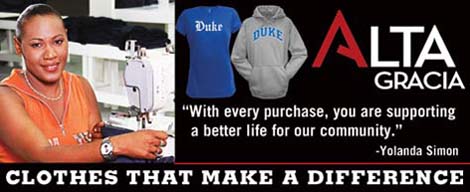Kelsey's Closet: Alta Gracia
To celebrate the release of the new updated and revised edition of Where Am I Wearing? I’m celebrating apparel companies that are making a difference by conducting two weeks of giveaways. Each day I’ll highlight a company and then giveaway an item of theirs at 9PM (ish). To enter, leave a comment in that day’s blog post or on Facebook. Winner will be randomly selected. Wanna see more clothing companies changing the world? Visit Kelsey’s Closet.

Rocking my Ball State Alta Gracia shirt
Leave a comment in this post for a chance to win a shirt from Alta Gracia
One of the best stories to develop in the garment industry since the 1st edition of Where Am I Wearing was released is the rise and success of Alta Gracia. I was thrilled to talk about the good work they are doing by connecting garment workers in the Dominican Republic to students in the United States in the new edition. To make their induction into Kelsey’s Closet, here’s an excerpt from the new edition.
From the closing chapter of the new edition of Where Am I Wearing?
The apparel industry has a lot of issues, including child labor and sweatshops, but these are all just symptoms of the real problem: poverty.
There’s a reason a single mom of three children in Bangladesh will work for $24 per month. There’s a reason a young woman in Cambodia will pay a month’s wages as a bribe to land a job. There’s a reason a worker in China will clock out and go back to work for free instead of telling his boss to shove it. They all have an extreme lack of options—because they all live in poverty.
New York Times columnist Nicholas Kristof agrees, and wrote in a January 14th 2009 column: “. . . sweatshops are only a symptom of poverty, not a cause, and banning them closes off one route out of poverty.” But I’m not so sure about his assessment that working in a sweatshop is a route out of poverty. It might be for some, but working in a garment factory wasn’t a route out of poverty for Nari or Ai or Arifa or any worker I’ve ever met (most of whom are no longer garment workers five years after I met them). Their situations haven’t improved. Amilcar looked at his family’s needs, assessed his career as a garment worker, and decided to take his chances traveling north into an unknown future. A job at a “sweatshop” might be the best of a host of not-great opportunities, but it rarely does more than keep people just on the edge of extreme poverty.
Kristof claims that developing countries need more sweatshops. But I disagree. Developing countries need more jobs like those at soleRebels and Alta Gracia, jobs that allow parents to send their kids to school. The garment industry has huge—relatively untapped—potential to fight poverty.
Bethlehem projects that soleRebels (here’s link to my radio report on soleRebels) will have 300 full-time employees by 2015. Let’s say that every worker at soleRebels has six kids (based on Ethiopia’s fertility rate). This means that over 1,800 kids will be supported by jobs at the company by 2015. The workers, with the help of the company, are able to send all six kids to school. And since these kids have an education, they don’t grow up to be shoemakers. They do something that pays better, and they send their six kids to school. By the third generation, the 300 jobs at soleRebels will have impacted 64,800 people. Within six generations, the jobs will have impacted over two million.
I realize that this calculation might be a bit oversimplified, but my point is that a job, a good job, has an exponential impact.
Another brand that is changing lives is Alta Gracia, a brand manufactured in the Dominican Republic that makes T-shirts and sweatshirts for university bookstores across the country. They pay their workers a living wage, which happens to be three times the average wage at other such factories in the country. They are open to the workers unionizing, and allowing me to work alongside their employees on the factory floor. Actually, when I made my request, the brand’s parent company, Knights Apparel, wasn’t the only group that decided it would be okay. The workers liked the idea, too. I’m hoping to take them up on the job offer someday.
The fact that they are this open is simply amazing—as is the fact that I’m not the only one they’ve invited to their factory. Alta Gracia’s union regularly receives visitors at the factory and has Skype calls with American students. The Worker Rights Consortium also regularly visits the factory and checks the pay-records at least once per week.
The New York Times reported on Alta Gracia from the Dominican Republic on July 17th, 2010:
Sitting in her tiny living room here, Santa Castillo beams about the new house that she and her husband are building directly behind the wooden shack where they now live.
The new home will be four times bigger, with two bedrooms and an indoor bathroom; the couple and their three children now share a windowless bedroom and rely on an outhouse two doors away.
Ms. Castillo had long dreamed of a bigger, sturdier house, but three months ago something happened that finally made it possible: she landed a job at one of the world’s most unusual garment factories. Industry experts say it is a pioneer in the developing world because it pays a “living wage”—in this case, three times the average pay of the country’s apparel workers— and allows workers to join a union without a fight.
“We never had the opportunity to make wages like this before,” says Ms. Castillo, a soft-spoken woman who earns $500 a month. “I feel blessed.”
“It’s a noble effort, but it is an experiment,” Andrew Jassin, co-founder of Jassin Consulting, an apparel industry consultant, quoted in the same story. “There are consumers who really care and will buy this apparel at a premium price, and then there are those who say they care, but then just want value.”
You’re a consumer. Do you care?
(end of the excerpt, now this is me today)
Today, Alta Gracia is more than an experiment. Notre Dame just unveiled their official shirt, made by Alta Gracia, for the 2012-2013 football season and their book store announced they hope to carry $500,000 of Alta Gracia apparel in the near future.
Alta Gracia is succeeding, and with each T-shirt sold, they are proving that consumers do care.
Leave a comment in this post for a chance to win a shirt from Alta Gracia
Channel One’s report on Alta Gracia:


I think the problem is more of our global capitalist economic system and neoliberalism which creates poverty, but thanks for writing this. yay alta gracia!
I heard Alta Gracia workers at a fair trade conference talk about what their job means to them and how having a living wage has changed their lives. It was very inspirational and I think Alta Gracia is really lighting the way for a more ethical garment industry, thank you for acknowledging them!
I have been doing an unpaid internship with Alta Gracia the past two semesters at the University of Wisconsin-Madison and am continuing it into into next year due to the immense passion I have developed for the labor rights and the crucial campaign to put an end to sweatshops. I was lucky enough to visit the factory over winter break and meet the workers and their families…there is honestly nothing more inspiring and rewarding than that. AG stands as an incredible model that should be used as the poster child for the aparrel industry worldwide but the only way this
is possible is to continue to educate communities and dramatically increase awareness…only then will real change happen!
So great! It’s nice to see the impact our simple materialistic purchases make.
Sign me up
Mara K! Congrats! You win win the Alta Gracia shirt! I’ll shoot you an email with details.
Hi,I read your blog named “Kelsey’s Closet: Alta Gracia | Kelsey Timmerman” on a regular basis.Your writing style is awesome, keep doing what you’re doing! And you can look our website about تحميل افلام.
I appreciate what you did. 토토 추천